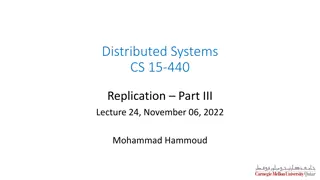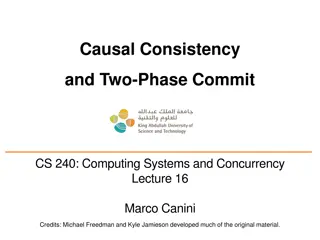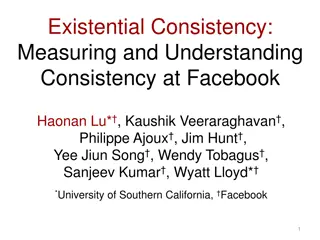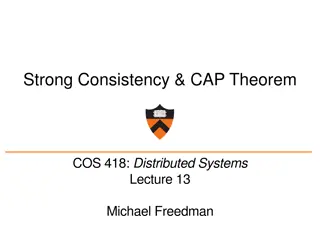Understanding Strong Consistency & CAP Theorem in Computing Systems
Explore the concepts of strong consistency, CAP theorem, network partitions, linearizability, and how systems handle partitions. Delve into the trade-offs between consistency, availability, and partition-tolerance as outlined by the CAP theorem.
Download Presentation

Please find below an Image/Link to download the presentation.
The content on the website is provided AS IS for your information and personal use only. It may not be sold, licensed, or shared on other websites without obtaining consent from the author. Download presentation by click this link. If you encounter any issues during the download, it is possible that the publisher has removed the file from their server.
E N D
Presentation Transcript
Strong Consistency & CAP Theorem CS 240: Computing Systems and Concurrency Lecture 15 Marco Canini Credits: Michael Freedman and Kyle Jamieson developed much of the original material.
Outline 1. Network Partitions 2. Linearizability 3. CAP Theorem 4. Consistency Hierarchy 2
How can we handle partitions? Totally-ordered Multicast? Bayou? Viewstamped Replication? Chord? Paxos? Dynamo? RAFT? 5
Fundamental trade-off? Replicas appear to be a single machine, but lose availability during a network partition OR All replicas remain available during a network partition but do not appear to be a single machine 7
CAP theorem preview You cannot achieve all three of: 1. Consistency 2. Availability 3. Partition-Tolerance Partition Tolerance => Partitions Can Happen Availability => All Sides of Partition Continue Consistency => Replicas Act Like Single Machine Specifically, Linearizability 8
Outline 1. Network Partitions 2. Linearizability 3. CAP Theorem 4. Consistency Hierarchy 9
Linearizability [Herlihy and Wing 1990] All replicas execute operations in some total order That total order preserves the real-time ordering between operations If operation A completesbefore operation B begins, then A is ordered before B in real-time If neither A nor B completes before the other begins, then there is no real-time order (But there must be some total order) 10
Linearizability == Appears to be a Single Machine Single machine processes requests one by one in the order it receives them Will receive requests ordered by real-time in that order Will receive all requests in some order Atomic Multicast, Viewstamped Replication, Paxos, and RAFT provide Linearizability 11
Linearizability is ideal? Hides the complexity of the underlying distributed system from applications! Easier to write applications Easier to write correct applications But, performance trade-offs, e.g., CAP 12
Outline 1. Network Partitions 2. Linearizability 3. CAP Theorem 4. Consistency Hierarchy 13
CAP conjecture[Brewer 00] From keynote lecture by Eric Brewer (2000) History: Eric started Inktomi, early Internet search site based around commodity clusters of computers Using CAP to justify BASE model: Basically Available, Soft- state services with Eventual consistency Popular interpretation: 2-out-of-3 Consistency (Linearizability) Availability Partition Tolerance: Arbitrary crash/network failures 14
CAP theorem [Gilbert Lynch 02] Assume to contradict that Algorithm A provides all of CAP Client 1 Client 1
CAP theorem [Gilbert Lynch 02] Assume to contradict that Algorithm A provides all of CAP Client 1 Client 1 Partition Possible (from P)
CAP theorem [Gilbert Lynch 02] Assume to contradict that Algorithm A provides all of CAP w(x=1) Client 1 Client 1 ok Write eventually returns (from A) Partition Possible (from P)
CAP theorem [Gilbert Lynch 02] Assume to contradict that Algorithm A provides all of CAP w(x=1) r(x) Client 1 Client 1 ok x=0 Read begins after write completes Read eventually returns (from A) Write eventually returns (from A) Partition Possible (from P)
CAP theorem [Gilbert Lynch 02] Assume to contradict that Algorithm A provides all of CAP Not consistent (C) => contradiction! w(x=1) r(x) Client 1 Client 1 ok x=0 Read begins after write completes Read eventually returns (from A) Write eventually returns (from A) Partition Possible (from P)
CAP interpretation 1/2 Cannot choose no partitions 2-out-of-3 interpretation doesn t make sense Instead, availability OR consistency? i.e., fundamental trade-off between availability and consistency When designing system must choose one or the other, both are not possible
CAP interpretation 2/2 It is a theorem, with a proof, that you understand! Cannot beat CAP theorem Can engineer systems to make partitions extremely rare, however, and then just take the rare hit to availability (or consistency)
More trade-offs L vs. C Low-latency: Speak to fewer than quorum of nodes? 2PC: write N, read 1 RAFT: write N/2 + 1, read N/2 + 1 General: |W| + |R| > N L and C are fundamentally at odds C = linearizability, sequential, serializability (more later) 22
PACELC If there is a partition (P): How does system tradeoff A and C? Else (no partition) How does system tradeoff L and C? Is there a useful system that switches? Dynamo: PA/EL ACID dbs: PC/EC http://dbmsmusings.blogspot.com/2010/04/problems-with-cap-and-yahoos-little.html 23
Outline 1. Network Partitions 2. Linearizability 3. CAP Theorem 4. Consistency Hierarchy 24
Consistency models Contract between a distributed system and the applications that run on it A consistency model is a set of guarantees made by the distributed system e.g., Linearizability Guarantees a total order of operations Guarantees the real-time ordering is respected
Stronger vs weaker consistency Stronger consistency models + Easier to write applications - More guarantees for the system to ensure Results in performance tradeoffs Weaker consistency models - Harder to write applications + Fewer guarantees for the system to ensure
Consistency hierarchy Linearizability (Strong/Strict Consistency) e.g., RAFT Sequential Consistency e.g., Bayou Causal+ Consistency Eventual Consistency e.g., Dynamo
Strictly stronger consistency A consistency model A is strictly stronger than B if it allows a strict subset of the behaviors of B Guarantees are strictly stronger Linearizability is strictly stronger than Sequential Consistency Linearizability: total order + real-time ordering Sequential: total order + process ordering Process ordering Real-time ordering
Intuitive example Consistency model defines what values reads are admissible wall-clock time P1: w(x=a) P2: w(x=b) P3: r(x)=? r(x)=? P4: r(x)=? r(x)=? 29
Intuitive example Consistency model defines what values reads are admissible Time when process issues operation wall-clock time P1: w(x=a) P2: w(x=b) P3: r(x)=? r(x)=? Time when process receives response P4: r(x)=? r(x)=? 30
Linearizability Any execution is the same as if all read/write ops were executed in order of wall-clock time at which they were issued Therefore: Reads are never stale All replicas enforce wall-clock ordering for all writes wall-clock time P1: w(x=a) P2: w(x=b) P3: r(x)=? r(x)=? P4: r(x)=? r(x)=? 31
Linearizability: YES Any execution is the same as if all read/write ops were executed in order of wall-clock time at which they were issued Therefore: Reads are never stale All replicas enforce wall-clock ordering for all writes wall-clock time P1: w(x=a) P2: w(x=b) P3: r(x)=b r(x)=b P4: r(x)=b r(x)=b 32
Linearizability: NO Any execution is the same as if all read/write ops were executed in order of wall-clock time at which they were issued Therefore: Reads are never stale All replicas enforce wall-clock ordering for all writes wall-clock time P1: w(x=a) P2: w(x=b) P3: r(x)=a r(x)=b P4: r(x)=b r(x)=b 33
Sequential consistency Sequential = Linearizability real-time ordering 1. All servers execute all ops in some identical sequential order 2. Global ordering preserves each client s own local ordering With concurrent ops, reordering of ops (w.r.t. real-time ordering) acceptable, but all servers must see same order e.g., linearizability cares about time sequential consistency cares about program order
Sequential consistency Any execution is the same as if all read/write ops were executed in some global ordering, and the ops of each client process appear in the program order Therefore: Reads may be stale in terms of real time, but not in logical time Writes are totally ordered according to logical time across all replicas wall-clock time P1: w(x=a) P2: w(x=b) P3: r(x)=? r(x)=? P4: r(x)=? r(x)=? 35
Sequential consistency: YES Any execution is the same as if all read/write ops were executed in some global ordering, and the ops of each client process appear in the program order Therefore: Reads may be stale in terms of real time, but not in logical time Writes are totally ordered according to logical time across all replicas wall-clock time P1: w(x=a) P2: w(x=b) P3: r(x)=b r(x)=b P4: r(x)=b r(x)=b Also valid with linearizability 36
Sequential consistency: YES Any execution is the same as if all read/write ops were executed in some global ordering, and the ops of each client process appear in the program order Therefore: Reads may be stale in terms of real time, but not in logical time Writes are totally ordered according to logical time across all replicas wall-clock time P1: w(x=a) P2: w(x=b) P3: r(x)=a r(x)=b P4: r(x)=b r(x)=b Not valid with linearizability 37
Sequential consistency: NO Any execution is the same as if all read/write ops were executed in some global ordering, and the ops of each client process appear in the program order Therefore: Reads may be stale in terms of real time, but not in logical time Writes are totally ordered according to logical time across all replicas wall-clock time P1: w(x=a) P2: w(x=b) P3: r(x)=b r(x)=a P4: r(x)=b r(x)=a No global ordering can explain these results 38
Sequential consistency: NO Any execution is the same as if all read/write ops were executed in some global ordering, and the ops of each client process appear in the program order Therefore: Reads may be stale in terms of real time, but not in logical time Writes are totally ordered according to logical time across all replicas wall-clock time P1: w(x=a) w(x=c) P2: w(x=b) P3: r(x)=c r(x)=a P4: r(x)=b r(x)=a No sequentialglobal ordering can explain these results E.g.: w(x=c), r(x)=c, r(x)=a, w(x=b) doesn t preserve P1 s ordering 39
Causal+ Consistency Partially orders all operations, does not totally order them Does not look like a single machine Guarantees For each process, an order of all writes + that process s reads Order respects the happens-before ( ) ordering of operations + replicas converge to the same state Skip details, makes it stronger than eventual consistency
Causal+ But Not Sequential PA r(y)=0 w(x=1) PB w(y=1) r(x)=0 Casual+ X Sequential w(x=1) r(y)=0 Happens Before Order w(x=1) r(y)=0 Process Ordering w(y=1) r(x)=0 w(y=1) r(x)=0 PA Order: w(x=1), r(y=0), w(y=1) w(x=1) r(y)=0 No Total Order PB Order: w(y=1), r(x=0), w(x=1) w(y=1) r(x)=0
Eventual But Not Causal+ PA w(y=1) w(x=1) PB r(y)=1 r(x)=0 Eventual X Causal+ As long as PB eventually would see r(x)=1 this is fine w(x=1) w(y)=1 Happens Before Ordering r(y)=1 r(x)=0 w(x=1) w(y)=1 No Order for PB r(y)=1 r(x)=0






















